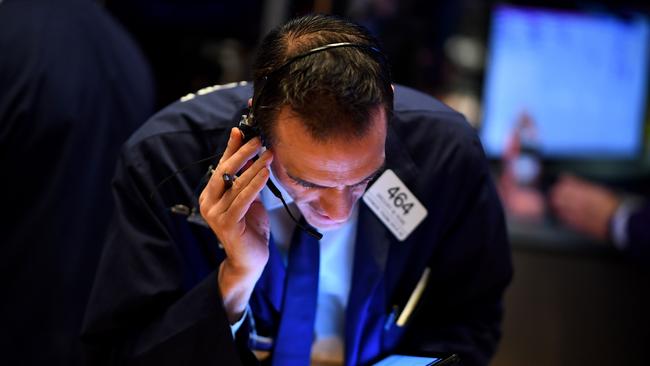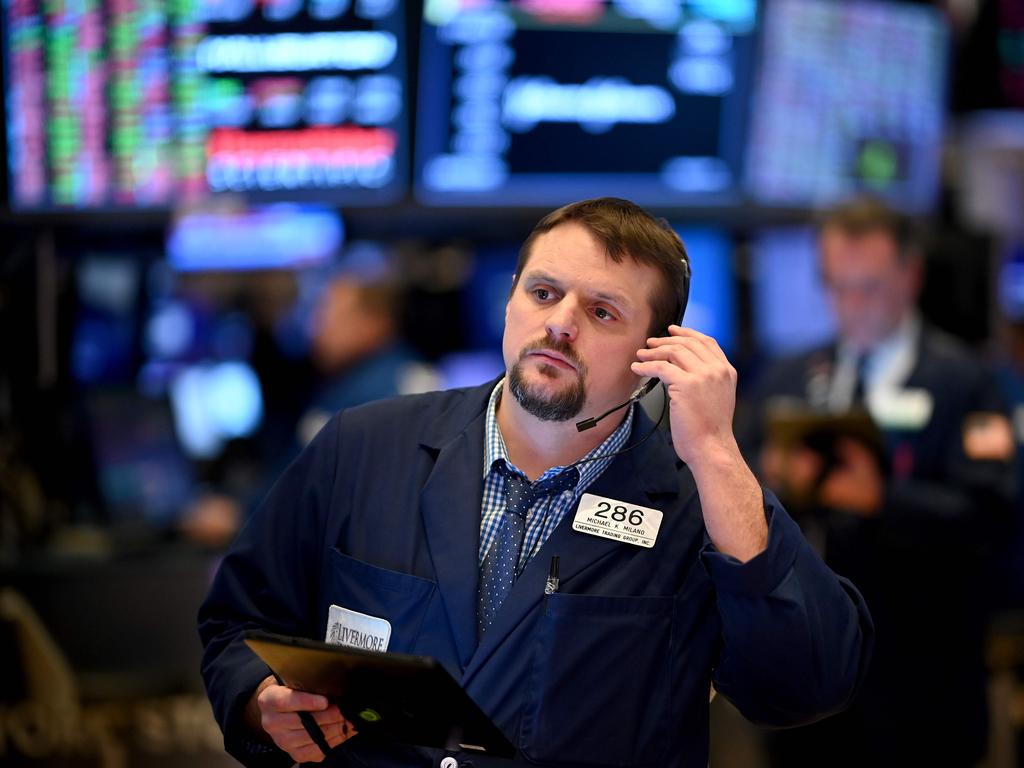Dow falls again to end worst week since 2008
Wall St sank again despite Fed moves to ease the impact of the virus crisis, although stimulus measures lifted European markets.

US stocks fell to cap another bruising week on Wall Street as fresh measures to contain the coronavirus pandemic spooked investors.
Major indexes opened slightly higher but pulled back after New York Governor Andrew Cuomo ordered the state’s workforce to stay home, following a similar edict in California. Stocks sank further after the Trump administration said US borders with Mexico and Canada would be closed to non-essential travel.
The Dow Jones Industrial Average dropped 916 points, or 4.6 per cent, its worst week since October 2008. The drop also put the blue-chip index about 35 per cent below its alltime high set less than two months ago.
The S&P 500 sank 4.4 per cent, while the tech-heavy Nasdaq Composite dropped 3.8 per cent.
All three indexes were poised to close the week with losses of at least 11 per cent as the pandemic is expected to cause a sharp downturn in the US economy.
Europe markets rise
Earlier, European stocks pushed higher as the ECB unleashed fresh stimulus to boost the economy as coronavirus grips the continent.
In the eurozone, markets jumped after the European Central Bank and EU took unprecedented measures to prop up their economies as confinement measures to slow the spread of the coronavirus causes massive disruptions to businesses.
Paris ended the day with a gain of five per cent and Frankfurt nearly four per cent. London’s stock market won only 0.8 per cent as an anticipated new UK state stimulus plan failed to materialise.
It came after Australia’s benchmark S&P/ASX 200 share index closed up 0.7 per cent on Friday, leaving it with a massive 13 per cent slide for the week and a 33 per cent bear market slump from a record high four weeks ago.
In major developments:
* The Australian dollar was a little higher on Saturday morning, at US57.82c.
* Australia’s SPI futures index on Saturday morning was pointing to a fall of 87 points.
* Oil markets failed to extend a rebound following a directive from US President Donald Trump to top up the Strategic Petroleum Reserve to its maximum capacity by buying a total of 77 million barrels from US producers. Brent fell back below $US30 per barrel and West Texas Intermediate tumbled more than 10 per cent at one point to under $US23 per barrel.
* The US Federal Reserve, in its latest effort to pump funds into the US economy, announced new measures to enhance liquidity in state and municipal money markets.
The program will be administered by the Federal Reserve Bank of Boston and make loans to financial institutions secured by high-quality assets such as tax-free municipal bonds.
* Leading central banks announced a new effort to keep dollars pumping through the virus-plagued world economy. Starting on Monday, certain dollar liquidity operations among the banks will occur daily rather than weekly, according to a joint statement from the Federal Reserve, European Central Bank, Bank of Japan, Bank of England, Bank of Canada and the Swiss National Bank.
* The European Commission said the EU would suspend its strict rules on public deficits to allow governments to open the money taps to face the coronavirus pandemic. In an unprecedented decision, Brussels triggered something called the “general escape clause”, giving countries free rein to “inject spending into the economy as needed,” EU chief Ursula von der Leyen said.
* New York state moved to join California in ordering nearly all residents to stay in their homes.

Meanwhile analysts at Goldman Sachs said they expect US growth to contract 24 per cent in the second quarter, far outpacing the largest quarterly drop in gross domestic product on record -- the first quarter of 1958 when the economy contracted 10%.
The yield on the 10-year US Treasury note fell back below 1 per cent as investors sought the safety of government bonds. The 10-year yield was recently at 0.932 per cent, down from 1.121 per cent Thursday. Yields move in the opposite direction from prices.
Lawmakers in Washington are working on a huge stimulus package, encompassing aid to businesses and individuals, that could top $US1 trillion.
The Federal Reserve has also taken aggressive steps to alleviate stresses on markets. The central bank has offered to temporarily provide billions of dollars at near-zero rates to central banks grappling with greenback shortages in many parts of the world. Earlier in the week, it said it would launch a new lending facility to backstop money-market mutual funds -- an operation that it expanded Friday to include municipal debt.
Some analysts said the moves by the Fed and other central banks had a stabilising effect.
“All the measures that central banks have taken over the past week have started to feed into the system and improve liquidity,” said Seema Shah, chief strategist at Principal Global Investors.
Despite Friday’s losses, some beaten-down stocks found relief, at least temporarily. MGM Resorts International gained 19 per cent, cruise-line operator Carnival added 20 per cent and United Airlines Holdings rose 18 per cent. Are three stocks have still lost more than 70 per cent of their value so far this year.
Zoom Video Communications, whose teleconferencing software has gotten heavy use as lockdowns have forced millions of Americans to work from home, climbed 4.7 per cent on Friday.
“You can see investors starting to turn to opportunities in the midst of the selling,” said Mike Loewengart, managing director of investment strategy at E*Trade.
Adding to the volatility, Friday was a “quadruple witching” day on Wall Street, meaning options and futures on both indexes and stocks were set to expire simultaneously. Such days are often marked by heavy volumes and outsize swings.
Oil prices slid, giving back many of their gains from Thursday’s big rally. US crude futures fell 11 per cent to $US22.53 a barrel. They dropped 29 per cent for the week. Futures on Brent crude, the global oil benchmark, fell 5.2 per cent to settle at $US26.98 a barrel.
The disruption caused by the outbreak in the US and elsewhere is starting to become apparent: state-level information suggests jobless claims could hit more than 2 million, an unprecedented level, in next Thursday’s report on the US market, according to Goldman Sachs Group.
The disease that the virus causes, COVID-19, has killed more than 11,000 people, according to data from Johns Hopkins University. The majority of these deaths have taken place in China, Italy and Iran. Globally there are more than 263,000 confirmed cases of the novel coronavirus, the data show.
Treasury Secretary Steven Mnuchin said Friday that the US would extend the individual tax filing deadline to July 15, giving a break to households whose normal life has been up-ended by lockdowns and mounting lay-offs.
Strains in the bond market have been eased by massive new bond-buying programs by the Fed, the Bank of England and European Central Bank, said Paul Jackson, global head of asset allocation at Invesco.
The measures, coupled with efforts by governments to support businesses and people facing months of disruption, have given investors hope that “the economic fallout, which is going to be big, will at least be minimised,” Mr Jackson said.
Still, given the extreme volatility in global markets over the past few weeks, the mood among market participants remained subdued.
“Any day that you see a little bit of a rally, it tends to last a day at most, because the underlying problem of the virus is still there,” said ING’s Mr. Carnell.
Overseas, the pan-continental Stoxx Europe 600 rose 1.8 per cent. South Korea’s Kospi soared to 7.4 per cent, recouping much of the previous day’s losses. Hong Kong’s Hang Seng Index gained 5 per cent, while the Shanghai Composite Index closed 1.6 per cent higher.
Dow Jones Newswires, Agencies






To join the conversation, please log in. Don't have an account? Register
Join the conversation, you are commenting as Logout